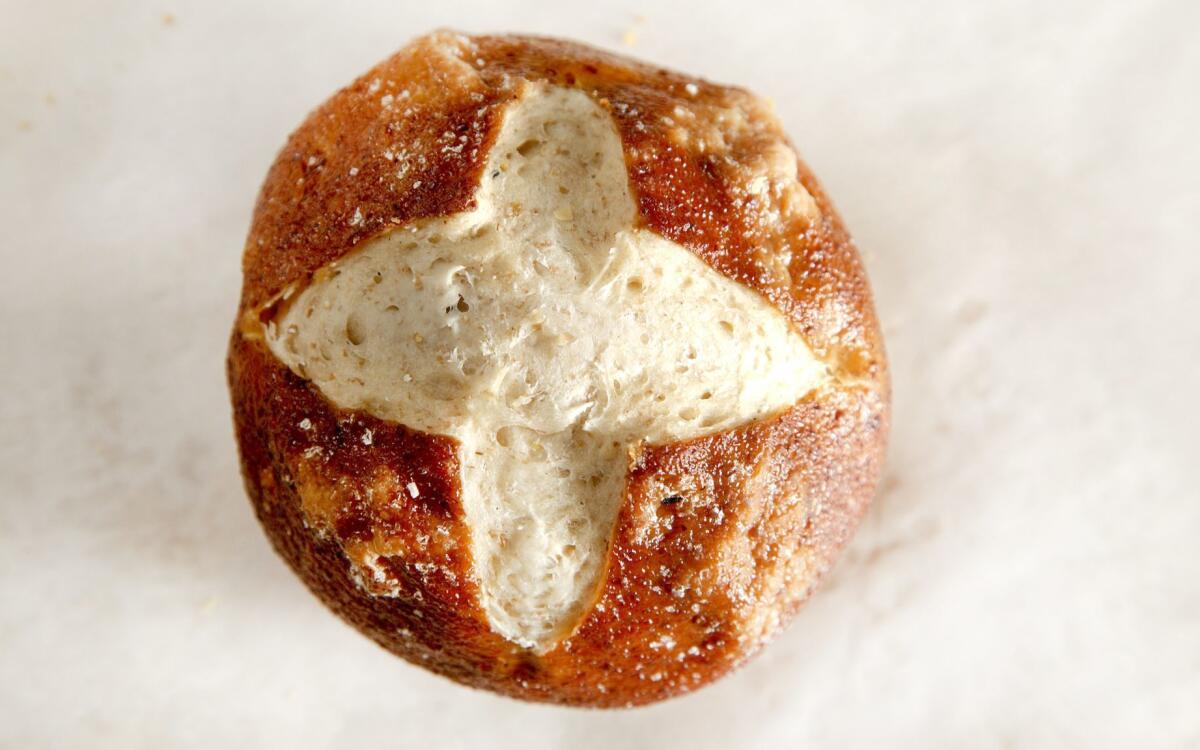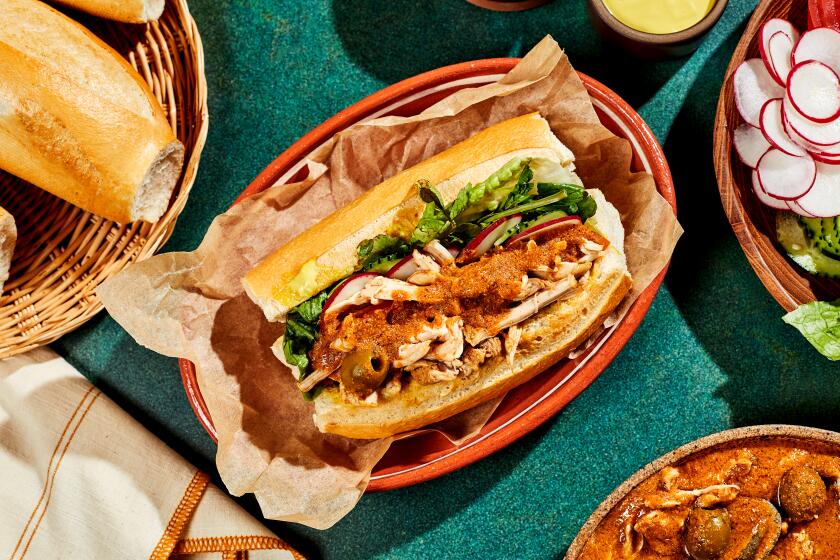Pretzel buns

- Share via
If Memorial Day is the unofficial start to grilling season, then Father’s Day is the celebratory kickoff. This is the time when we get our last live-fire exercises in before the 4th of July, when the summer season really gets underway. And, if you’re like me, you might just be thinking about burgers this weekend.
To any real fan, a hamburger is never just a burger. Rather, it’s a work of art, passionately thought out and painstakingly executed. A great burger is the very extension of the grill master’s identity, the perfect blend of meat for flavor and just enough fat to keep it juicy and rich, flavored with the right mix of spices. Top that beauty with colorful veggies, a slathering of homemade sauce and maybe — just maybe — your own homemade pickles, and most of us would call it a masterpiece.
But what about the bun?
All too sadly, most of us shop for the first buns we see in the market. We test for fluffiness (just like those old Charmin commercials), check for a bedazzling of sesame seeds and call it a day. But consider hamburger buns in the same way you would pizza crust — you don’t want them stealing the show, but they should be able to hold their own with the rest of the parade. If you’re going to all that trouble with the fillings, why not care about the bookends?
Here are three classic burger bun recipes for when you plan your cookouts this summer. They’re surprisingly easy to make — most of the time is spent waiting for the dough to rise — and you can’t beat the flavor.
Brioche buns are unpretentiously rich, full of butter and eggs, but still light and fluffy, and brushed with a thick coating of egg and milk wash for an extra-shiny golden sheen when they come out of the oven.
The honey whole wheat are a tad more healthful for the virtuous among us. With a nearly equal blend of whole wheat and bread flours, they’re light, almost airy, rather than dense, with just enough honey to balance the flavors of the whole grains.
But my favorite might be the pretzel buns: Made with a blend of rye and bread flours, the buns are dipped in an easily orchestrated lye dip to give them their characteristic flavor and coloring. (You could easily skip the wash and brush them with egg for coloring and sheen, topping the finished product with coarse sea salt.)
While you’re at it, don’t forget to add your favorite flavorings to the buns, personalizing any of the recipes to suit your tastes. Flavor the dough with fresh herbs, spices or cheese; top them with sesame, poppy, sunflower or other seeds, or maybe old-fashioned oats or nuts.
A freshly made batch of buns is just the right compliment the burgers you’ve been perfecting — and they also work well sandwiching brisket, pulled pork or any other glorious concoctions you plan on conquering this summer season.
BREAD WASHES
Bread recipes frequently call for some sort of “wash” or glaze before baking. Sometimes, a recipe may call for egg, sometimes milk, even butter. Different washes are used to achieve different results. So how do you choose the right one for your project?
EGG: Using beaten whole eggs will give color and sheen to a bread. Egg yolk provides rich color, browning easily in the oven; egg white provides a nice sheen.
MILK: Brushing with milk will lend color to the crust, as the sugars in the milk help to brown it.
WATER: Water is often sprayed or brushed onto bread before it is placed in a very hot oven — and while it bakes — to give the bread an extra-crisp crust. Water added to an egg wash thins the wash so it brushes more easily.
BUTTER: Butter gives the bread a softer crust and richer flavor.
SWEETENERS: Honey, maple syrup, agave and other liquid sweeteners will give bread a sweeter, softer crust.
In the bowl of a stand mixer or in a large bowl, sprinkle the yeast over the warm water. Stir in the sugar and one-half cup of the bread flour. Set aside until the yeast begins to bubble, about 10 minutes.
Meanwhile, in a medium bowl, whisk together the remaining bread flour with the rye flour and salt.
Beat the melted butter into the large bowl with the yeast. Using the dough hook (if using a stand mixer) or a fork or wooden spoon (if mixing by hand), slowly mix in the remaining flour mixture, a spoonful at a time, until all of the flour is added and a firm, thick dough is formed.
Move the dough to a lightly floured board. Knead the dough until it is smooth and elastic, 2 to 3 minutes.
Remove the dough to a large, oiled bowl. Cover and set aside in a warm place until the dough is almost doubled in size, 45 minutes to an hour.
Meanwhile, prepare the pretzel wash and heat the oven to 375 degrees.
Divide the risen dough into eight pieces, each weighing about 5 ounces. Form each piece into a ball, pinching the seams together at the base of each one. Flatten each ball so it’s about 1 inch thick.
Coat the pretzels with a wash. If using lye, dip the roll in the wash (wear rubber kitchen gloves and goggles) for 15 to 20 seconds, turning the roll over halfway to coat evenly. Remove the round to a greased nonreactive baking sheet and top as desired (if using an aluminum baking sheet, line the sheet with parchment before greasing). If using beaten egg, brush the egg over the buns.
Use a serrated knife or razor blade to make a crosswise slit into each roll about one-half-inch deep. Sprinkle over the coarse sea salt. Set the rounds aside until puffed and risen, about 15 minutes depending on the temperature in the room.
Bake the pretzel rounds, one sheet at a time, in the center of the oven until puffed and a rich golden brown (color will vary depending on the wash), about 20 minutes. Rotate the sheet halfway through baking for even coloring.
Remove the baking sheet to a rack, and set aside until the pretzel buns have cooled completely before slicing and serving.
Get our Cooking newsletter
Get a taste of Los Angeles — and the world — with recipes and kitchen tricks from the L.A. Times’ Cooking newsletter.
You may occasionally receive promotional content from the Los Angeles Times.
















